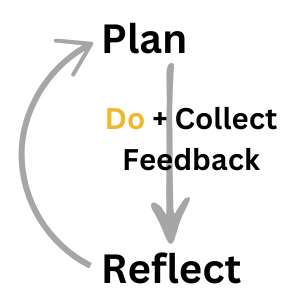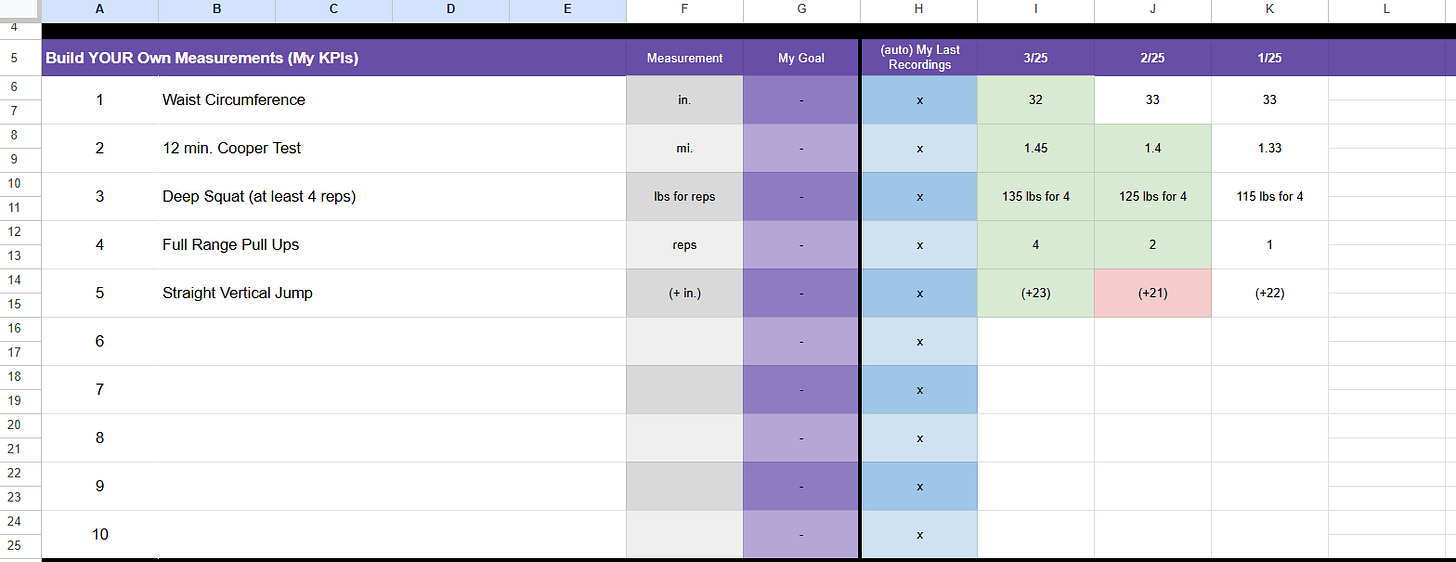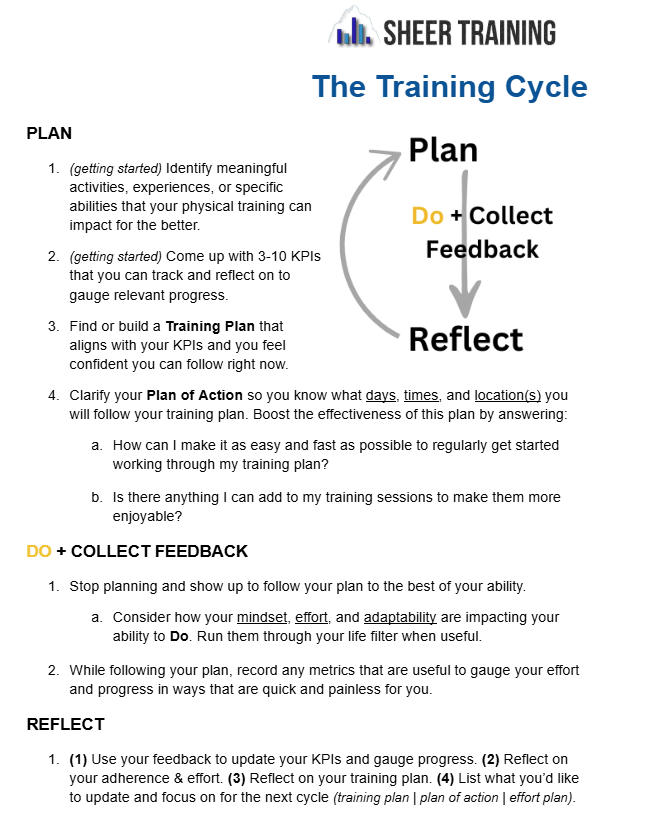(Part 5) How Training Can Change Your Life
A timely method to reflect with purpose (and conclusion)
This is Part 5 (our final part) on how training can change your life. Here are the previous parts that build up to today if you haven’t read them yet:
Part 1 (setting your KPIs)
Part 2 (designing your plan for success)
Part 3 (the real life approach to doing)
Part 4 (collecting useful feedback)
Parts 1 & 2 make up the PLAN step and parts 3 & 4 make up the DO + COLLECT FEEDBACK step of this 3-step Training Cycle. With both of these steps in place we can now bring it all together by reflecting on our process and progress to help us make more informed future decisions.
Timely Method for Purposeful Reflection
Reflecting is a super power we are given as humans. We have the mental ability to be self-aware, think back on our experiences, learn from others experiences, and contemplate patterns of cause and effect to help us better understand what is effective.
We reflect to some extent all the time; whether conscientiously or unconsciously.
However, it’s all too easy to neglect the full power of purposeful reflection, dismissing it as an activity we don’t have the time or energy to commit to (speaking from personal experience here).
One of the mental obstacles I see to purposeful reflection is that without boundaries on how you do it there’s no limit to how long it takes you and no telling if you walk away from it with any meaningful (actionable) ideas.
The unknown time and energy demand is then too much to consider fitting into your busy life.
When we decide on a useful model for reflecting with purpose we can clarify how long we will spend and what understandings we want to walk away with, SO THAT our thoughtful takeaways improve how we spend our time and energy in our lives moving forward.
I want to offer an approach to a useful model for reflecting with purpose (and then you can use it, adapt it, or use it as motivation to find another model that works better for you)
Here’s the overview of my Reflection model:
#1 Update and Gauge Progress on Your KPIs
#2 Reflect on Your Adherence and Effort
#3 (if you had high adherence & effort) Reflect on the Effectiveness of Your Training Plan
#4 Based on your progress and reflections, list anything you’d like to update and focus on for the next cycle
#1 - Start with updating your KPIs
Look over your KPI metrics, use your feedback that you’ve collected, and add a new column or row with the updated KPIs metrics to reflect where you are at currently for each of them.
Using the example KPI template I offered in Part 1, here’s an example of recording your KPIs on Sheer Training’s My Training Bars Self-Reflection Sheet. I personally like to shade improvement in green, lowered ability/results in red, and anything unchanged stays white. This just helps me visually see trends quicker when reflecting over months of progress.
Compare the difference from now to your past KPI logs to see where you made progress.
Then consider if these KPIs are still great physical representatives of the activities, experiences, or specific abilities that you care about.
If YES, move on to step #2.
If NO, update your KPIs and then move to the next steps with the KPIs you’ve kept
#2 - Reflect on your adherence and effort
Key Question: Were you able to give a consistent and progressive effort?
For consistency: were you able to complete 90% or more of the plan?
For progressive: were you able to give high efforts throughout the plan? If yes, were you able to do a little bit more than before in some areas?
If YES, (awesome) move on to step #3.
If NOT, what happened that threw off your consistency or effort?
[important mindset] Critical judgement is unnecessary and unhelpful here. This is feedback to help you understand what might need to change.
This is a likely response when living a full life. While we can’t blame the plan in this case, we may still need to change it to allow us to give a more consistent and progressive effort.
List any factors that threw off your consistency or effort and then consider the following:
For consistency: how could I reduce the time demand or improve environmental factors to make my time commitment more efficient?
For effort: do I need to address a pain issue, adjust my energy plan, address my sleep or stress management practices, or accept that my higher energy has to be directed in other areas that are not training right now?
Is a new program approach more appropriate for what I’m able to follow right now?
Then go to step #4.
#3 - Reflect on your plan
If you followed the plan with consistency and progressive effort then you can reflect of how well it worked for you:
Based on at least some of the KPI results and how you feel overall, was the plan a success?
If YES, do I want to keep doing it as is or would I like to make any adjustments?
If SOMEWHAT, where could I update the plan (or my approach to it) to possibly be more effective (test it over the next training cycle)
If NO, either this plan may need some big changes or I may need to try a new approach with a different plan. Seek out education/understanding of what to try next. What might that look like?
#4 - My takeaways
After you have gauged the progress you made on any of your KPIs and connected your results (or lack of results) to the effort you gave and plan you followed, you can now determine what to focus on as you smoothly transition into your Planning Step of the Training Cycle.
Using how you answered Steps #2 and #3, list what you want to focus on for the next Training Cycle. These will be your prime considerations for what tweaks or changes you make to your training plan and plan of action.
That’s it for the Reflection Step.
I then recommend task batching and using that same train of thought to go right into your planning step and update it with what you want to do for the next Training Cycle.
Both the Reflection and Plan step can be completed with purpose in 20-40 min. and then you can direct your focus back on to Doing and Collecting Feedback, while living life, for the duration of your next plan (usually 4-6 weeks).
It may take a little longer if you have to do some research to improve your education/understanding, but as you learn what works, that is knowledge about how to take care of yourself that you will have with you for the rest of your life.
In Fit for Life Premium you and I would work through the Reflection and Planning Steps together in our monthly 1 on 1 Strategy Session (I offer this option at $199/month).
This sets you up with a personalized game plan for how to approach the upcoming month of training and what nutrition or recovery actions to focus on.
Other Important Considerations When Reflecting
(1) Your KPIs may not always improve, even when doing everything right.
As your physical abilities improve to a certain level, it will take more effort, time, and targeted approaches to keep improving them.
For most, at some point this trade-off ends up taking more from their life than giving. It’s a personal decision, so if you do see it as a worthy trade-off then by all means keep pursuing progress in those KPIs.
If the further time and energy are not worth it to you, once that KPI has hit a level of ability that you feel good about and progress has seemed to slow down drastically you can look at a couple of different ways:
See it as a KPI that you want to keep tabs on to maintain that influential ability while potentially still seeing some small progress (with your expectations aligned)
Decide to replace this KPI with another one that you believe you have more progress to be made with (this could be considered a weak-link that you’d like to direct more focus on)
You could remove the KPI and have less to track altogether, but if it really is an influential metric, I think it would be worth at least keeping tabs on it so that you don’t start slacking in that area unintentionally.
(2) There’s a difference between feedback that helps your session to session effort and feedback that serves your reflection step.
In Part 4 I discussed how recording your efforts in each session reveals your past self. This helps you know what you have been capable of and how you can try to increase the challenge just a little bit more to keep improving at a pace that is right for you.
This is useful for every movement you are doing with a high effort or a feel good effort.
This type of feedback collected serves your Session to Session Effort. You are recording more information but you are assessing it one movement at a time as you approach that session or movement again (typically the following week).
In this way, it should not be an overwhelming amount of information to digest. Instead this promotes more mindful training.
When using feedback for your reflection step, you want to narrow down to only reflecting on your KPI metric’s data, adherence percentages, and possibly that cycle’s averages of data (for data such as avg. sleep, avg. resting heart rate, avg. HRV, etc.).
This limits what you are looking at down to a mentally consumable level for understanding certain metrics that you believe directly impact what you care about.
These select KPI metrics, percentages, and averages are the feedback that serves your Reflection Step.
(3) Feeling great is underrated.
I love the process of having KPIs and seeing measurable improvement over time. I like the objectivity of data and I believe it helps us make more intelligent decisions.
BUT at the base of all of that objective feedback, there is a real beauty to simply feeling great in the body you have!
Feeling great is a blend of doing objectively good things for your body and subjectively having the mindset that wants to feel great and perceives the effort you are giving as valuable effort toward feeling great.
If you don’t make measurable improvements during a certain training cycle after doing everything near perfectly, that is not a waste of effort.
If what you were actually able to do over the training cycle barely resembles the plan you had for that month, that is not a failure.
Giving any effort toward improving your wellness and physical abilities does matter toward feeling better in your body; regardless of what outcomes you see from the selective metrics you have decided to track.
The metrics matter, but they don’t tell you the whole story of what you are doing for your body when you are training and incorporating better nutritional and recovery practices into your lifestyle (3-10 metrics and some single out averages can’t encompass everything affected in your body from the effort you gave - your body is too complex!).
I encourage you to use the Training Cycle as a fun way to approach improving yourself (helping you problem solve and add more purpose to your movement), but don’t take it so seriously that it stresses you out (there’s enough other stuff going on in life to do that for you already).
Feeling great (or even feeling better) is awesome. It’s valuable.
Yes it’s subjective, but it can make everything else in your life a little more enjoyable (or a little more tolerable), and if you take the time to notice it, it’s just as real as a metric you can track.
When reflecting on how things are going, don’t forget to check-in with how you are feeling overall; and when you notice that you’re feeling pretty good, enjoy it!
Bringing the Training Cycle All Together
Here is the complete model of the 3-Step Training Cycle:
Conclusion: Why I Say Training Can Change Your Life
I titled this series “How Training Can Change Your Life” with the word play to try and communicate how to use the Training Cycle and to express how meaningful it can be to have a more intentional approach to self-improvement.
In terms of physical training, I think the Training Cycle offers a valuable framework for more motivation and effective use of your time when trying to stay healthy, get in shape, become a better athlete, enjoy your active hobbies, or whatever you value.
Changing your life may be a strong statement. But I see it as this: imagine living your life not knowing if you’re getting any better, not sure what to do to change your circumstances, and maybe not even knowing what you would enjoy getting better at.
Now imagine having a system or model for identifying personally meaningful ambitions, feeling clarity on how to gauge progress and problem solve to pursue improvement toward those ambitions, and enjoying your life as you make progress in areas that matter to you.
I believe that could be pretty life changing for most people out there (including me).
In terms of using this for your physical health, you are given one body to use for your whole life. Everything you do to take care of your body and to improve it impacts everything else you do in your life.
Our bodies also directly impact how we feel and think through the hormonal and neural responses of when we move, what we consume, and how rested we are. So at least during this life, who you are and your body are very closely connected.
To clarify, I’m not at all talking about how we look or morality. I’m talking about what we do for our bodies on a daily basis directly affects how we function, feel, and think.
For these reasons, I believe using a more intentional method for great physical health and improvement could be viewed as life changing.
Thanks for reading! If anything resonates with you or you have a different approach to training that you like, I’d enjoy hearing from you.
Brian







